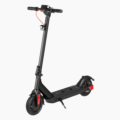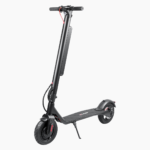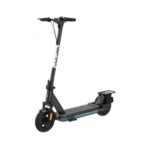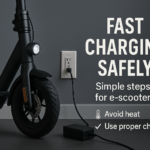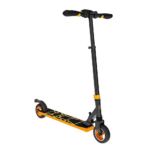- Home
- Scooters
- Electric Scooters
- TurboAnt M10
TurboAnt M10
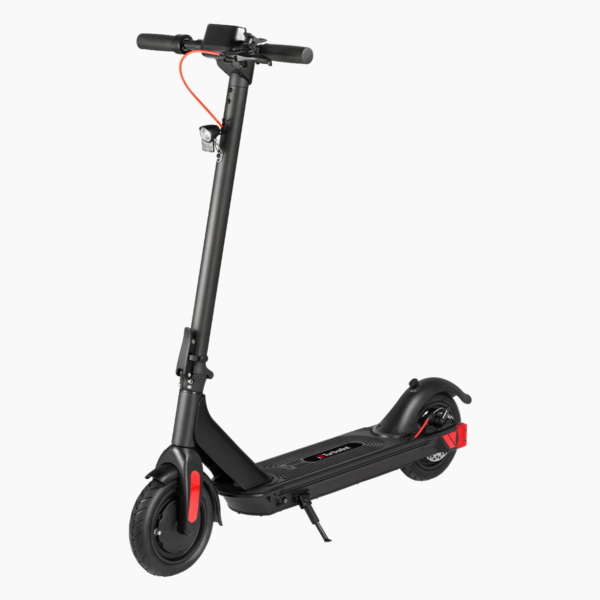

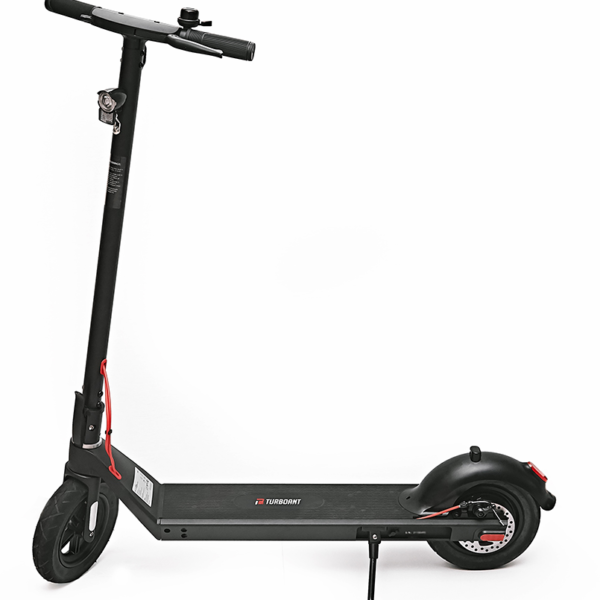
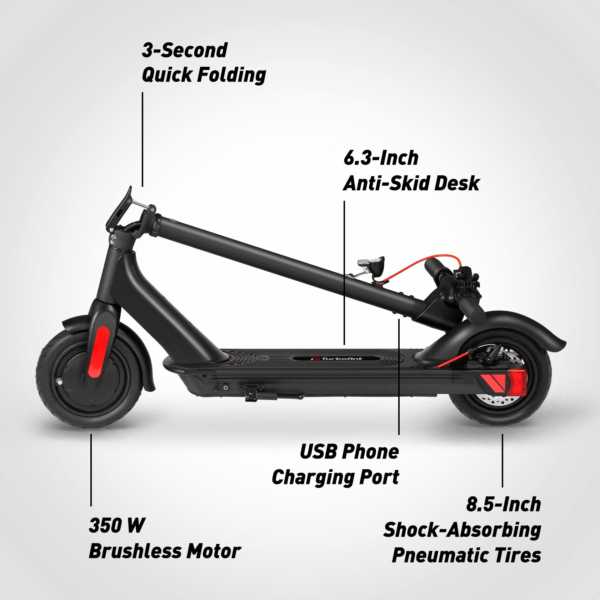
- Battery Range: 18 miles (29 km)
- Top Speed: 20 mph (32 km/h)
- Motor Power: 350 W
- Weight Capacity: 220 lb (100 kg)
- Charging Time: ~4–6 h
- Scooter Weight: 29.8 lb (13.5 kg)
PROS
- Light 29.8 lb (13.5 kg) frame
- 10″ pneumatic tires
- 20 mph (32 km/h) top speed
- Rear disc + electronic brake
- Simple, reliable controls
CONS
- Shorter 18-mile (29 km) range
- No suspension
- No Bluetooth app
Table of contents
- What Is the TurboAnt M10?
- How the TurboAnt M10 Works
- Key Specifications
- Design & Build Quality
- Performance Fundamentals
- Battery, Range & Efficiency
- Ride Quality & Comfort
- Braking & Safety Features
- Portability & Daily Usability
- Maintenance & Care
- Weather & Seasonal Considerations
- TurboAnt M10 vs Alternatives
- Who the TurboAnt M10 Is (and Isn’t) For
- FAQs
- Glossary
- Final Thoughts
The TurboAnt M10 is a lightweight, foldable electric scooter designed for everyday city riding and short commutes. It pairs a front-hub motor with large pneumatic tires and a sturdy, simple frame, so most riders can learn it quickly and use it confidently. Moreover, because the design focuses on practicality rather than flash, it suits new riders, multi-modal commuters, and anyone who wants reliable last-mile transport without hassle.
What Is the TurboAnt M10?
At its core, the TurboAnt M10 is a no-nonsense commuter scooter. It uses a brushless front hub motor, a 36-volt battery system, and 10-inch air-filled tires. Rather than chasing extreme speed or off-road capability, it prioritizes predictable handling, easy folding, and a balanced riding posture. Consequently, it feels approachable on day one and remains low-maintenance over time.
Importantly, the M10 avoids complicated suspension hardware and app-dependent features. That decision reduces weight and keeps the scooter straightforward to use. You unfold the stem, power it on, pick a ride mode, and get moving. In addition, because the scooter stays compact and light, it fits well with trains, buses, rideshares, and small apartments.
How the TurboAnt M10 Works
Although electric scooters can sound technical, the M10’s core systems are easy to understand. Think of them as simple modules that cooperate, step by step:
Motor (front hub, brushless DC).
A 350-watt nominal motor sits in the front wheel. When you press the thumb throttle, the controller feeds current to the motor windings, creating magnetic force that turns the wheel. Because the motor is integrated into the hub, there are no chains or belts to maintain. As a result, the drive stays quiet and efficient.
Controller (the scooter’s “brain”).
The controller manages how much current reaches the motor. It listens to the throttle position, monitors battery voltage, and limits output to keep the system safe. Therefore, power delivery feels smooth rather than jerky, especially from a standstill.
Battery (lithium-ion pack with BMS).
A 36-volt pack supplies energy to the controller and motor. The Battery Management System (BMS) balances the cells and guards against over-charging, deep discharging, and short circuits. In practice, you get a consistent ride until the pack falls near its lower limit; then the scooter reduces power to stretch remaining range.
Throttle (thumb-operated).
A thumb throttle gives you precise control. Press farther to accelerate more, or ease off to cruise. After maintaining a steady speed for several seconds, cruise control can hold that pace automatically on straight sections. If you need to slow, a light brake tap cancels it immediately.
Brakes (rear mechanical + electronic regen).
The rear brake is a cable-actuated disc that creates direct friction at the wheel. In addition, the scooter applies an electronic brake on the front motor. When you brake gently, you typically feel the electronic system slow the front wheel first; then the rear disc adds firmer bite as you squeeze harder. Consequently, stops feel stable and predictable.
Because these parts are integrated tightly, the M10 behaves consistently in daily use. Power arrives smoothly, braking feels progressive, and the frame’s geometry keeps weight centered between both wheels. As a result, the learning curve is short and confidence builds quickly.
Key Specifications
Below you’ll find the official Key Specifications summarized into practical blocks. Values are manufacturer-rated where stated, with common units shown in both imperial and metric for quick reading.
General
| Item | Value |
|---|---|
| Model | TurboAnt M10 |
| Intended Use | Urban commuting and last-mile travel |
| Wheel/Tire Size | 10 in pneumatic (≈ 25.4 cm) |
| Frame Material | Aluminum alloy |
| Color | Black/gray (typical) |
Performance & Power
| Item | Value |
|---|---|
| Motor | 350 W nominal front hub (brushless DC) |
| Top Speed (rated) | Up to 20 mph (≈ 32 km/h) |
| Hill Grade (rated) | Up to ~15% (short hills with a running start) |
| Drive | Front-wheel hub motor |
Battery, Charging & Electrical
| Item | Value |
|---|---|
| System Voltage | 36 V |
| Battery Capacity | ≈ 7.5 Ah (≈ 270 Wh) |
| Estimated Range (rated) | Up to 18 miles (≈ 29 km) per charge |
| Charger | ≈ 42 V output |
| Charge Time | ≈ 4–5 hours from low state of charge |
| BMS Protections | Over-charge, over-discharge, short-circuit, temperature |
| Lights | Front LED headlight; rear tail/brake light |
Build & Dimensions
| Item | Value |
|---|---|
| Scooter Weight | ≈ 29.8 lb (≈ 13.5 kg) |
| Max Rider Load | Up to 220 lb (≈ 100 kg) |
| Unfolded Dimensions | Not published by manufacturer |
| Folded Dimensions | Not published by manufacturer |
| Deck Profile | Low-step platform; grippy surface |
| Kickstand | Side-mounted |
Safety & Control
| Item | Value |
|---|---|
| Brakes | Rear mechanical disc + front electronic (regen/E-ABS) |
| Tires | 10 in air-filled, tubed |
| Water Resistance | IP54 (splash-resistant) |
| Reflectors | Side reflectors (typical) |
| Bell | Handlebar bell (typical) |
Features & Extras
| Item | Value |
|---|---|
| Display | Central LED: speed, battery, mode |
| Ride Modes | Multiple (e.g., Eco/Standard/Sport) |
| Cruise Control | Yes (after maintaining a steady speed briefly) |
| Folding Mechanism | Stem latch with safety hook |
| Included in Box | Charger, manual, basic tool kit (typical) |
Warranty & Compliance
| Item | Value |
|---|---|
| Warranty | Limited manufacturer warranty (coverage by component) |
| Regional Compliance | Varies by market; follow local riding regulations |
If a detail isn’t listed above, the manufacturer has not published it publicly. In those cases, practical rider feedback and careful setup will matter more than a line on a sheet.
Design & Build Quality
The M10’s design leans into simplicity, which usually translates to fewer surprises. The frame uses aluminum alloy tubing with neat welds, and the deck sits low to the ground for easy balancing at stops. Because the deck is slim and grippy, it encourages a natural stance: front foot angled slightly forward, rear foot across or behind for stability. Furthermore, the low profile makes step-offs calm rather than abrupt.
The stem locks with a straightforward latch. It opens in seconds and folds down just as quickly. The hinge area feels reinforced, and the hook system that secures the folded stem to the rear has a reassuring snap when it engages. That matters when you’re lifting the scooter up stairs or sliding it into a car trunk. Additionally, the folded package stays compact, which simplifies storage in tight spaces.
Cockpit layout stays tidy. The center display shows speed, battery bars, and mode at a glance. The thumb throttle resides where your right hand naturally rests, so you don’t have to reach or twist. A bell sits within easy thumb range. Because the handlebars are not overly wide, lane filtering and elevator entries feel less awkward. Meanwhile, internal routing and short cable runs keep the front tidy and resistant to snagging.
Fit-and-finish is also consistent. Cable runs are short and routed close to the frame, and the deck’s grip layer covers the edges cleanly. The kickstand swings down without wobble, and the latch hardware sits flush, so it doesn’t catch on clothing or bags. Overall, the pieces you touch feel purposeful and solid.
Performance Fundamentals
Acceleration feel.
From a stop, the M10 eases into motion smoothly. The controller doesn’t dump full current instantly, so takeoffs stay controlled even for first-time riders. As speed climbs, the scooter pulls briskly up to mid-teens mph, then settles into a steady build until it tops out near the rated speed. Because the motor sits in the front wheel, initial grip favors dry pavement; on wet paint or leaves, a lighter thumb keeps the tire from slipping. If you roll on the throttle progressively, traction remains consistent.
Cruising stability.
At city speeds, the chassis tracks straight, and the stem feels composed. The long, low deck helps center your weight, while the 10-inch pneumatic tires round off bumps that would unsettle smaller wheels. On long paths, the scooter holds direction well, and cruise control reduces right-hand fatigue. Consequently, you can settle into a rhythm that feels relaxed and efficient.
Hill-climb behavior (≈ 7–10% grades).
On modest grades, the M10 benefits from a running start. If you maintain momentum before the incline, it can sustain mid-teens mph for a good portion of the hill. On steeper or longer climbs, expect speed to drop. Because the system protects itself, it won’t allow current spikes that could overheat the motor. Instead, you’ll feel a gradual taper that keeps the scooter within its limits. For very steep driveways, a short walking assist can be the fastest and safest solution.
Top-end composure.
Near its rated maximum speed, handling remains calm. The tires absorb small cracks and maintain a reassuring footprint. With a balanced stance—knees soft, arms relaxed—the scooter avoids headshake and tracks predictably through gentle curves. If the surface turns rough, slightly lower speed restores comfort immediately.
Battery, Range & Efficiency
Manufacturer range estimates consider moderate rider weight, smooth pavement, mild temperature, and mostly flat routes. In real life, variables shift constantly. Therefore, think of range as a band rather than a single hard number.
Rated vs. real-world range.
With a 36 V system and a pack around 270 Wh, the M10’s rated range up to 18 miles (≈ 29 km) assumes conservative speeds, few stops, and dry conditions. If you’re heavier, ride fast, climb hills, or stop frequently, you’ll likely see less. Conversely, lighter riders who cruise steadily in Eco or Standard mode often approach the high end of the band. For consistent results, start your week with similar routes and speeds, then compare charge levels at home.
Efficiency habits that help.
Because wind drag rises quickly with speed, dropping your cruising pace by even 2–3 mph can add noticeable miles. Additionally, maintaining tire pressure within the recommended range and avoiding jack-rabbit starts conserves energy. Smooth throttle application also reduces wasted bursts and heat. As a bonus, gentle riding lowers brake wear.
Charging best practices.
Lithium-ion packs prefer partial charges and moderate temperatures. You don’t need to top up to 100% every time. In fact, for daily short trips, charging to roughly 80–90% and avoiding deep discharges helps longevity. Furthermore, allow the pack to cool to room temperature before charging after a hard ride, especially in summer. When storage extends for weeks, leave the battery around 40–60% and top up monthly.
Cold and hot weather effects.
In cold weather, chemistry slows down—expect less punch and shorter range. In extreme heat, the BMS may restrict current to protect the cells. Storage between about 50–77°F (10–25°C) is ideal. If you park outside temporarily, shade the deck and avoid puddles that could splash the charge port.
Ride Quality & Comfort
Tires and pressure.
The 10-inch pneumatic tires are the M10’s primary suspension. Because they deform over bumps, they mitigate vibration and soften impacts far better than solid tires. Keep them inflated to the recommended PSI for your weight and conditions. Slightly lower pressure improves comfort and grip at the cost of a bit of range, while higher pressure rolls faster on smooth paths. For mixed routes, a middle-ground PSI usually feels best.
Suspension behavior.
Although there’s no mechanical suspension, the large air volume and flexible carcass of the tires do most of the comfort work. Over expansion joints, gravelly patches, and manhole lips, the scooter remains composed. On rougher surfaces, bend your knees like mini shock absorbers and keep your elbows loose; that body posture dramatically improves comfort and control. If you regularly face broken pavement, slower speeds and defensive lines further smooth the ride.
Ergonomics and stem flex.
The deck height and bar reach suit a wide range of riders. The stem feels solid under typical city loads, and noticeable flex is rare at commuter speeds. If you do feel a tiny amount over potholes, that’s normal; the long tube acts like a lever. However, it should never rattle or clunk. If you hear noises, inspect and gently tighten the hinge hardware per the manual. Additionally, periodic checks keep the latch crisp and rattle-free.
Braking & Safety Features
Dual-system braking.
The M10 blends electronic front braking with a rear mechanical disc. Light lever pulls activate the electronic brake first, which feels smooth and quiet. As you pull farther, the rear disc adds bite and shortens stopping distance. This two-stage feel is confidence-inspiring during surprise stops because it keeps the scooter stable and straight. For consistent results, squeeze rather than grab.
Brake technique.
On dry pavement, shift a touch of weight back under hard braking. Keep your knees soft and your shoulders square to the bars. In the wet, start braking earlier and with less force. Because the front tire houses the motor, traction management matters most on slippery surfaces. Therefore, slow down before turns and straighten the bars before firm stops.
Lights and visibility.
The front LED throws a focused beam that makes you more visible and lights up the near path. The rear light brightens when braking, signaling to cyclists and drivers. Add reflective clothing or a helmet light if you ride at dawn or dusk—visibility layers stack. Additionally, keep the lenses clean so output stays crisp.
Water resistance.
The IP54 rating means splash resistance, not submersion protection. Therefore, avoid pressure washers and deep puddles. Wipe the scooter dry after wet rides and store it indoors when possible. If you ride through a brief shower, a gentle towel-off and warm indoor rest protect both bearings and electronics.
Portability & Daily Usability
Weight and carrying.
Around 29.8 lb (≈ 13.5 kg) is manageable for most adults, particularly over short distances like station stairs or office entries. The folded package is tidy, with the stem secured to the rear for one-handed carry. If you need to move it farther, hold at the balance point where the weight feels neutral. Alternatively, roll it with the front wheel lightly touching the ground.
Folding mechanism.
The stem latch opens and closes quickly once you develop a routine. Always confirm the safety catch is fully engaged before riding. That quick double-check becomes a healthy habit, just like buckling a seat belt. In crowded entries, fold ahead of time to avoid blocking foot traffic.
Storage and parking.
For apartments, slide the scooter along a wall or under a desk. At cafes or brief stops, the kickstand holds the frame solidly. For longer stops, consider a compact lock location that doesn’t stress the latch area. As always, follow building rules, fire codes, and local regulations. Moreover, bring the charger only when you truly need it; less weight simplifies errands.
Multi-modal life.
Because the package is slim, it works well with buses and trains. Hold the front wheel forward so the scooter tracks in line as you walk. When entering elevators or tight hallways, tilt slightly on the rear wheel to pivot in place. Consequently, transitions between riding and walking feel fluid.
Maintenance & Care
A simple, regular routine keeps the M10 safe and smooth. In general, little bits of attention given often beat big fixes done rarely.
Before each ride (30–60 seconds).
- Check tire pressure by feel or gauge; reinflate as needed.
- Look over the tread for cuts or embedded debris.
- Squeeze the brake lever to confirm firmness.
- Glance at the hinge and latch; verify full lock-up.
- Check battery bars and pick your ride mode.
Weekly (or every ~50 miles / ~80 km).
- Inspect fasteners on the stem clamp, brake caliper, and rotor.
- Spin the wheels; listen for rubbing or scraping.
- Clean the deck and display with a damp cloth.
- Test the bell and lights.
- Verify the charge port cap seats fully after charging.
Monthly (or every ~200 miles / ~320 km).
- True the brake caliper if the rotor lightly rubs.
- Inspect the brake pads for wear; adjust cable tension.
- Examine tires for uneven wear; rotate front/rear if your mechanic approves.
- Check for play in the stem hinge; snug per the manual if needed.
- Wipe exposed hardware with a lightly oiled cloth to discourage corrosion.
Firmware/app habits.
The M10 typically isn’t app-dependent, which simplifies life. You won’t be prompted for constant updates, nor will you need to pair a phone to adjust core settings. Therefore, your main focus is mechanical condition and battery care. If you add third-party accessories, ensure wiring doesn’t pinch at the hinge.
Storage guidance.
Store indoors, away from extreme temperatures and humidity. If you pause riding for several weeks, charge to roughly half and top up monthly. Do not leave the charger connected indefinitely; lithium-ion prefers gentle cycles. Additionally, keep the deck dry and the tires off sharp edges.
Weather & Seasonal Considerations
Rain.
With IP54 splash resistance, the M10 tolerates wet commutes; however, you should moderate speed and lengthen braking distances. Painted lines, metal grates, and leaf piles become slick, so maintain a straighter path and avoid sudden throttle inputs. After wet rides, dry the scooter and let the pack return to room temperature before charging. If moisture lingers at the charge port, wait longer.
Heat.
In hot weather, reduce long, high-speed runs to keep heat in check. Park in the shade and avoid leaving the scooter in a sealed car. If the deck feels very warm after a climb, ride gently for a few minutes before powering off. Consequently, internal temperatures drop, which is kinder to cells and electronics.
Cold.
Below ~41°F (5°C), expect softer acceleration and reduced range. Keep your tires within spec and consider slightly lower pressure for grip on cold pavement. Charge indoors where temperatures are moderate. Additionally, dress for wind chill; warm gloves improve control.
Wind.
Headwinds drain range more than you might expect. Tuck in a bit, choose a calmer ride mode, and keep cadence smooth. Because the scooter is upright and slender, crosswinds are manageable; just keep a light touch and look where you want to go. If gusts rise suddenly, ease off the throttle and ride defensively.
TurboAnt M10 vs Alternatives
Electric scooters generally fall into a few classes. Understanding these groups clarifies where the M10 excels and where it merely suffices.
Compact commuter class (like the M10).
These scooters target portability, low maintenance, and easy handling. They typically use 8.5–10-inch tires, a 36 V system, and a simple folding latch. The M10 excels here by balancing tire comfort, stable geometry, and straightforward operation. If you prioritize predictable behavior, manageable weight, and daily reliability, this class—and the M10 specifically—shines. Moreover, the learning curve is friendly for first-time riders.
Performance commuters (heavier, faster).
Scooters in the next tier add larger batteries, stronger motors, and sometimes suspension. They climb faster and carry speed on hills, although they weigh more and consume more energy per mile. If your rides feature long, steep grades—or if you want brisk acceleration with a heavier backpack—consider the longer-range TurboAnt X7 Max as an alternative; it suits riders who value added range and stronger hill stamina, though you will likely sacrifice a bit of portability.
Entry-level or kid-focused scooters.
Some models are purpose-built for very young riders who need ultra-low speeds and simplified controls. In that case, the Hover-1 My First E-Scooter is designed specifically for children and casual, supervised play—therefore, it isn’t a commuter replacement for adults but can be a gentle introduction to e-riding skills.
Off-road or dual-motor class.
Aggressive tires, big suspension, and twin motors deliver serious thrust and trail capability. However, they are bulky, heavy, and overkill for tight city errand loops. Unless you truly ride rough paths, the added mass can become a burden in daily carry scenarios. Consequently, maintenance and storage also become more demanding.
In other words, the M10’s advantage is usability. It’s quick to fold, easy to lift, and ready for practical city trips. If you want something that “just works” without tinkering, its design choices make a lot of sense.
Who the TurboAnt M10 Is (and Isn’t) For
Ideal for:
- Students who need a fast, reliable way between campus buildings and transit stops.
- Multi-modal commuters who ride a scooter to the bus or train, then fold and carry onboard.
- New riders who want calm handling, smooth power, and forgiving tires while they build skills.
- Errand runners who value easy parking, quick folding, and compact storage in small apartments.
Less ideal for:
- Very hilly routes where steep, sustained grades exceed the scooter’s rated hill ability.
- High-speed enthusiasts who want aggressive acceleration and 25+ mph cruising.
- Heavy cargo haulers who regularly carry loads beyond the rated rider weight or who need a front basket and rear rack system.
If your priorities match the first list, you’ll likely appreciate the M10 right away. Its specifications align with stress-free transport rather than sport riding, which is exactly what many city travelers actually need. Conversely, if you crave rapid acceleration and deep range reserves, a larger class will fit better.
FAQs
1) Is the TurboAnt M10 street-legal where I live?
Regulations vary widely by region and even by city. Generally, you should ride in bike lanes where allowed, follow posted speed limits, yield appropriately, and use lights at night. When unsure, check local rules before riding and choose conservative speeds.
2) How far can I ride on one charge?
Under favorable conditions and moderate speeds, many riders approach the rated range up to 18 miles (≈ 29 km). However, hills, headwinds, frequent stops, higher speeds, cold weather, and heavier loads reduce real-world range. Therefore, plan buffers into your routes.
3) Does the M10 have cruise control?
Yes. After holding a steady speed for several seconds, the scooter can maintain that pace automatically. Tap the brake or change throttle input to disengage. Consequently, long straight paths feel less tiring.
4) What tire maintenance does the M10 require?
Keep the 10-inch pneumatic tires inflated within the recommended PSI range, inspect for debris or cuts, and avoid curbing impacts. Proper pressure improves comfort, grip, and efficiency. Additionally, check valves for slow leaks.
5) How does the brake feel on the M10?
It’s progressive. The electronic front braking provides gentle initial deceleration, while the rear disc adds firmer bite as you pull more lever. This layered feel makes stops predictable. For shorter stops, begin early and add pressure smoothly.
6) Can I ride the M10 in the rain?
The IP54 rating covers splashes and light rain, not immersion. Ride cautiously on wet surfaces, avoid deep puddles, and dry the scooter after use. Charge only when the scooter has returned to room temperature. If in doubt, wait longer.
7) Where can I find a concise TurboAnt M10 overview?
You’re reading it. This article delivers a practical TurboAnt M10 overview with the essential details, plus setup and care tips to keep it running smoothly.
Glossary
Ah (amp-hours).
A measure of battery capacity based on how much current a pack can, in theory, supply over time.
Wh (watt-hours).
Total energy capacity (voltage × amp-hours). Higher Wh generally means more range, all else equal.
Controller.
The electronic module that manages current flow to the motor, smoothing acceleration and protecting components.
BMS (Battery Management System).
A system that balances cells and guards against unsafe conditions like over-charge or short-circuit.
Regen (regenerative braking).
Electric braking where the motor acts like a generator, converting some motion back into electrical resistance and heat.
E-ABS.
An electronic anti-lock strategy that modulates motor braking to maintain traction and stability.
Stem Flex.
Slight bending in the handlebar stem under load. A small amount is normal; clunks indicate a loose hinge or hardware.
IP Rating.
Ingress Protection rating indicating resistance to dust and water. IP54 means limited dust ingress and splash resistance.
Hub Motor.
A motor integrated into the wheel hub, eliminating belts or chains for quiet and low-maintenance drive.
Pneumatic Tire.
An air-filled tire that deforms over bumps to improve comfort and grip.
Ride Modes.
Pre-set power maps (e.g., Eco or Sport) that change acceleration and top-speed behavior.
Cruise Control.
A feature that maintains a steady speed automatically after you hold the throttle constant for a few seconds.
Peak Power vs. Nominal Power.
Nominal is the continuous rating the motor can handle. Peak is a short burst available briefly for acceleration.
Wheelbase.
Distance between the front and rear wheel centers. Longer wheelbases track straighter; shorter ones turn more sharply.
Rolling Resistance.
Energy lost when tires deform against the road. Higher pressure lowers resistance but reduces compliance.
Final Thoughts
The TurboAnt M10 focuses on what most city riders actually need: smooth operation, predictable handling, comfortable tires, and an easy fold. Its motor and battery deliver sensible pace and range for short to medium urban trips, while the chassis remains compact enough for elevators and transit. Because maintenance is light and the controls are intuitive, the M10 makes adopting e-scooting feel simple rather than technical. Moreover, the balanced geometry keeps rides calm even when paths get busy.
If your daily routine involves quick errands, a mixed commute, or a campus loop, this scooter fits neatly into that lifestyle. It starts with approachable power, adds low-stress braking, and finishes with a tidy fold. In short, its specifications and design choices favor practical transport over flash—and that’s precisely why it works so well for so many riders.
Specifications
General
| Model The Model specifies the exact version or name of the scooter. It helps identify its unique design, features, and specifications within the manufacturer’s product line. Knowing the model makes it easier to compare options, find compatible accessories, or look up support information. | M10 |
| Brand The Brand identifies the manufacturer or company that designs and produces the scooter. A trusted brand is a sign of quality, reliability, and good customer support. Well-known brands often have higher standards for safety, performance, and after-sales service, giving you more confidence in your purchase. | TurboAnt |
| Release Date The Release Date indicates when the scooter model was officially launched on the market. This helps you know how current the design, technology, and features are. A newer release date often means updated components, improved performance, and the latest safety or smart features. | 17 November 2025 |
| Recommended Age Recommended Age indicates the minimum age range that the scooter is designed for, based on safety, size, and ease of use. Following the recommended age helps ensure that riders can handle the scooter’s speed, weight, and controls comfortably and safely. Always check local laws and use protective gear, especially for younger riders. | 16+ |
Performance & Power
| Motor Power (Wattage) What it means: The motor power, measured in watts (W), shows how strong the scooter’s electric motor is. Why it matters: Higher wattage usually means better acceleration, more torque, and improved performance on hills or rough terrain. For example, a 250W motor is good for flat city roads and light riders, while a 500W or 1000W motor provides more power for faster speeds or climbing steep inclines. | 350 W rear hub motor |
| Top Speed The Top Speed indicates the maximum speed that the scooter can reach under optimal conditions. It’s usually measured on level ground with a fully charged battery and an average rider weight. A higher top speed allows you to travel longer distances faster, but always ensure you ride within legal speed limits and your personal comfort zone for safety. | 20 mph (32 km/h) |
| Battery Capacity Battery Capacity refers to the total amount of energy the scooter’s battery can store, usually measured in ampere-hours (Ah) or watt-hours (Wh). A higher battery capacity means you can ride longer distances on a single charge, reducing the need for frequent recharging. Keep in mind that actual range can vary depending on rider weight, terrain, speed, and weather conditions. | 36 V 7.5 Ah (270 Wh) |
| Estimated Range per Charge The Estimated Range per Charge indicates the average distance the scooter can travel on a single full battery charge. This range is calculated under optimal conditions, such as flat terrain, moderate speed, and average rider weight. Real-world range may vary depending on riding style, terrain, weather, and load. A longer range means fewer recharges and greater freedom for longer trips. | 18 miles (29 km) |
| Hill Climb Ability Hill Climb Ability describes the maximum incline or slope that the scooter can handle while maintaining stable performance. It’s typically expressed as a percentage or in degrees. A higher hill climb rating means the scooter can tackle steeper hills without losing too much speed or power. Actual climbing performance may vary based on rider weight, battery charge, and terrain conditions. | 15% |
| Drive System The Drive System refers to how power from the motor is delivered to the wheels. Electric scooters typically use either a hub motor (directly integrated into the wheel) or a chain/belt drive system. A high-quality drive system ensures smooth acceleration, efficient power transfer, and low maintenance. The choice of drive system affects performance, noise level, and overall ride experience. | Rear hub (RWD) |
Charging & Electrical
| Charging Time Charging Time indicates how long it takes to fully recharge the scooter’s battery from empty to 100% using the standard charger provided. Faster charging means less downtime and more time on the road. Actual charging time may vary slightly depending on battery capacity, charger output, and environmental conditions. | Approx. 4–6 hours |
| Battery Type Battery Type refers to the specific technology used in the scooter’s battery, which affects performance, lifespan, weight, and charging time. Most modern electric scooters use high-quality lithium-ion (Li-ion) batteries because they offer a good balance of energy density, durability, and low maintenance. A reliable battery type ensures consistent power delivery and longer riding ranges. | Lithium-ion pack with Smart BMS |
| Removable Battery A Removable Battery means the battery pack can be easily detached from the scooter for convenient charging and replacement. This feature allows you to charge the battery separately, swap it with a spare for extended range, or securely store it indoors in extreme weather. Removable batteries add flexibility and make it easier to keep your scooter powered up wherever you are. | Non-removable internal battery (fixed pack) |
| Regenerative Braking Regenerative Braking is an energy-saving feature that converts some of the energy normally lost during braking back into battery power. When you slow down or brake, the motor works in reverse to generate electricity, which helps extend the scooter’s range and improves overall efficiency. This system also reduces wear on traditional brake components, leading to lower maintenance over time. | Yes (via electronic brake) |
| Lighting Lighting refers to the built-in front and rear lights that enhance visibility and safety when riding in low-light conditions or at night. Good lighting helps you see the road ahead and ensures that other road users can see you. Many scooters include LED headlights, taillights, and sometimes brake lights or side reflectors for added safety and compliance with local traffic regulations. | LED headlight + rear LED/brake + reflectors |
Build & Dimensions
| Scooter Weight Scooter Weight refers to the total weight of the scooter when fully assembled, including the battery. This affects how easy it is to carry, lift, and store the scooter when not in use. A lighter scooter is more portable and convenient for commuting, especially if you need to carry it upstairs or onto public transport. Keep in mind that a sturdy frame and quality components may add to the weight but also contribute to better durability and ride stability. | 29.8 lb (13.5 kg) |
| Maximum Rider Weight Maximum Rider Weight indicates the highest rider weight that the scooter is designed to safely support while maintaining optimal performance and stability. Staying within this limit helps ensure reliable acceleration, braking, and climbing ability, and it protects the frame, suspension, and motor from excessive strain. Exceeding the recommended limit may reduce performance and increase wear on components. | 220 lb (100 kg) |
| Deck Size Deck Size refers to the dimensions of the scooter’s standing platform. A wider and longer deck provides more foot space, allowing you to stand comfortably and adjust your stance while riding. A well-sized deck improves balance and stability, especially on longer rides or at higher speeds. Compact decks, on the other hand, help keep the scooter lightweight and portable. | Slim folding stem; low deck |
| Handlebar Height Handlebar Height refers to the distance from the deck to the handlebars, which affects your riding posture and comfort. An appropriate handlebar height helps you maintain good balance, reduces strain on your back and arms, and makes steering more comfortable. Some scooters have adjustable handlebars to fit riders of different heights, while others have a fixed height for a streamlined design. | Fixed |
| Folding Mechanism The Folding Mechanism describes how easily and securely the scooter can be folded for carrying and storage. A well-designed folding system lets you quickly collapse the scooter into a compact size, making it convenient to transport on public transit, store under a desk, or fit into a car trunk. Look for sturdy latches and safety locks to ensure the scooter stays firmly in place when folded or unfolded. | Quick-fold latch |
| Dimensions Folded Dimensions indicate the size of the scooter when it’s fully folded. This measurement shows how much space the scooter will take up when stored or carried, making it easier to check if it will fit in your car trunk, under a desk, or in a closet. Compact folded dimensions are ideal for commuters who need to bring their scooter on public transport or store it in tight spaces. | Folded: Not specified; Unfolded: Not specified |
| Material Material refers to the primary construction materials used for the scooter’s frame and key components. High-quality materials like aircraft-grade aluminum, reinforced steel, or durable composites provide strength, stability, and a lighter overall weight. A sturdy material ensures the scooter can handle daily wear and tear while maintaining safety and performance. | Aluminum alloy |
Safety & Control
| Brake Type(s) Brake Type(s) describe the braking systems the scooter uses to help you slow down or stop safely. Common brake types include mechanical brakes (like drum or disc brakes), electronic brakes, and foot brakes. Many scooters combine multiple braking systems for added safety and shorter stopping distances. The type and quality of brakes affect your control, especially when riding at higher speeds or on slopes. | Front electronic + rear mechanical disc |
| Suspension Suspension refers to the system that absorbs shocks and vibrations while riding, providing a smoother and more comfortable ride over uneven or rough surfaces. Scooters may have front suspension, rear suspension, or dual suspension for better shock absorption and stability. Good suspension helps reduce rider fatigue and improves control, especially when riding on bumpy roads or off-road paths. | None |
| Tire Type Tire Type refers to the kind of tires the scooter uses, which directly affects ride comfort, traction, and maintenance. Common types include solid (airless) tires, pneumatic (air-filled) tires, or hybrid options. Pneumatic tires offer better shock absorption and a smoother ride on rough surfaces, while solid tires are puncture-proof and require less upkeep. The right tire type helps ensure safe handling and a comfortable ride in different conditions. | 10″ pneumatic street tires |
| Tire Size Tire Size indicates the diameter and width of the scooter’s tires, which affect ride comfort, stability, and how well the scooter handles different terrains. Larger tires generally offer better shock absorption and a smoother ride over bumps and rough surfaces, while smaller tires keep the scooter lighter and more portable. Choosing the right tire size helps ensure a balance between agility and comfort. | 10-inch |
| Kickstand The Kickstand is a built-in stand that allows you to park your scooter upright when it’s not in use. A sturdy kickstand keeps the scooter stable and prevents it from tipping over, protecting it from scratches and damage. It also makes storing and accessing your scooter more convenient, whether you’re at home, work, or on the go. | Side kickstand |
| Water Resistance Rating Water Resistance Rating indicates how well the scooter is protected against water and moisture, usually shown as an IP (Ingress Protection) rating. This rating helps you understand whether the scooter can handle light rain, splashes, or wet roads without damage. While most scooters are not fully waterproof, a good water resistance rating adds peace of mind when riding in changing weather conditions. Always avoid deep puddles or submerging the scooter to protect its electrical components. | IPX4 |
Features & Extras
| Display/Console The Display (or Console) shows important real-time information about your ride, helping you monitor your scooter’s status at a glance. Typical displays show speed, battery level, distance traveled, and riding mode. Some models also include additional features like Bluetooth connectivity, app integration, or backlighting for better visibility at night. A clear and easy-to-read display enhances safety and convenience on every trip. | LED display (speed, battery, mode) |
| Ride Modes Ride Modes refer to the different speed and power settings you can choose to match your riding style or road conditions. Common modes include eco for maximum range and energy efficiency, standard for everyday balance, and sport or turbo for higher speed and stronger acceleration. Switching between ride modes allows you to customize performance, conserve battery, and ride safely in various environments. | Eco/Drive/Sport (3 modes) |
| Smart App Connectivity Smart App Connectivity lets you pair your scooter with a dedicated mobile app via Bluetooth. Using the app, you can monitor real-time ride stats like speed, battery level, and range, adjust settings such as ride modes or cruise control, lock the scooter for added security, and sometimes receive firmware updates. This feature adds convenience and allows you to personalize your riding experience right from your smartphone. | No app |
| Anti-Theft System The Anti-Theft System helps protect your scooter from unauthorized use or theft. This feature can include built-in alarms, electronic motor locks, GPS tracking, or remote locking through a mobile app. A good anti-theft system provides peace of mind when parking your scooter in public spaces, adding an extra layer of security to safeguard your investment. | Not specified |
| Cruise Control Cruise Control allows you to maintain a steady speed without continuously holding the throttle. This feature makes longer rides more comfortable by reducing hand fatigue and providing a smoother, more relaxed riding experience — especially on flat, open roads or bike lanes. For safety, cruise control can usually be easily activated or deactivated while riding. | Yes (cruise control) |
| Accessories Included Accessories Included lists the additional items that come with the scooter to enhance your riding experience and convenience. Common accessories may include a charger, kickstand, bell, lights, phone holder, or carrying strap. These extras add value by making your scooter safer, easier to use, and ready to ride straight out of the box. | Scooter, charger (42 V / 2 A), tools, manual |
Warranty & Compliance
| Warranty Period The Warranty Period indicates how long the manufacturer guarantees the scooter against defects in materials and workmanship under normal use. A good warranty provides peace of mind, showing the brand’s confidence in its product quality. Always check what parts are covered, such as the frame, battery, and motor, and follow the maintenance guidelines to keep your warranty valid. | 12 months (region-dependent) |
| Certifications Certifications confirm that the scooter meets specific safety, quality, and environmental standards set by recognized organizations or regulatory bodies. Common certifications may include CE, RoHS, UL, or other local compliance marks, depending on your region. These certifications ensure that the scooter is manufactured to high standards and is safe and legal to use in your country. | Local micromobility compliance |


